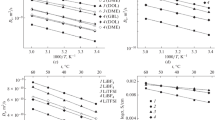Abstract
We have fabricated a class of colloidal electrorheological (ER) fluids, in which suspended TiO2 particles were synthesized by a sol-gel method and modified by 1,4-butyrolactone molecules with a permanent molecular dipole moment of 4.524 D. Compared with pure TiO2 ER fluids, the quasi-static yield stress of the polar- molecules-modified ER fluid is enhanced as high as 48.1 kPa when subjected to an external electric field of 5 kV/mm. Also, it possesses other attractive characters such as low current density (<14 μA/cm2) and low sedimentation. Based on a Green’s function method, we present a first-principles approach to investigate colloidal electrostatic interactions. Excellent agreement between experiment and theory has been shown for the enhancement ratio of quasi-static yield stress, which quantitatively reveals that enough polar molecules oriented within the field-directed gap between the colloidal particles can unexpectedly enhance the interactions, thus yielding the unusual enhancement. This shows a promising and flexible direction for achieving more highly active ER materials.











Similar content being viewed by others
References
J. Li, D.L. Dai, X.D. Liu, Y.Q. Lin, Y. Huang L. Bai: Preparation and characterization of self-formed CoFe2O4 ferrofluid. J. Mater. Res. 22, 886 2007
J. Thessing, J.H. Qian, H.Y. Chen, N. Pradhan X.G. Peng: Interparticle influence on size/size distribution evolution of nanocrystals. J. Am. Chem. Soc. 129, 2736 2007
C.W. Cho, S.K. Kim, U. Paik, J.G. Park W.M. Sigmund: Atomic force microscopy study of the role of molecular weight of poly(acrylic acid) in chemical mechanical planarization for shallow trench isolation. J. Mater. Res. 21, 473 2006
Y.C. Weng, L. Rusakova, A. Baikalov, J.W. Chen N.L. Wu: Microstructural evolution of nanocrystalline magnetite synthesized by electrocoagulation. J. Mater. Res. 20, 75 2005
U.T. Gonzenbach, A.R. Studart, E. Tervoort L.J. Gauckler: Ultrastable particle-stabilized foams. Angew. Chem., Int. Ed. Engl. 45, 3526 2006
J. Wang, D.Y. Wang, N.S. Sobal, M. Giersig, M. Jiang H. Mohwald: Stepwise directing of nanocrystals to self-assemble at water/oil interfaces. Angew. Chem., Int. Ed. Engl. 45, 7963 2006
X.W. Zhao, Y. Cao, F. Ito, H.H. Chen, K. Nagai, Y.H. Zhao Z.Z. Gu: Colloidal crystal beads as supports for biomolecular screening. Angew. Chem., Int. Ed. Engl. 45, 6835 2006
D.S. Zhou, J.F. Zhang, L. Li G. Xue: Control of the geometry of the adsorbed thin layer by the depletion interaction. J. Am. Chem. Soc. 125, 11774 2003
T.C. Halsey: Electrorheological fluids. Science 258, 761 1992
T. Hao: Electrorheological fluids. Adv. Mater. 13, 1847 2001
Y.L. Zhang, K.Q. Lu, G.H. Rao, Y. Tian, S. Zhang J.K. Liang: Electrorheological fluid with an extraordinarily high yield stress. Appl. Phys. Lett. 80, 888 2002
R. Tao J.M. Sun: 3-dimensional structure of induced electrorheological solid. Phys. Rev. Lett. 67, 398 1991
M. Whittle W.A. Bullough: Materials science: The structure of smart fluids. Nature 358, 373 1992
W.J. Wen, X.X. Huang, S.H. Yang, K.Q. Lu P. Sheng: The giant electrorheological effect in suspensions of nanoparticles. Nat. Mater. 2, 727 2003
J.B. Yin X.P. Zhao: Giant electrorheological activity of high surface area mesoporous cerium-doped TiO2 templated by block copolymer. Chem. Phys. Lett. 398, 393 2004
T. Yogo, T. Yamamoto, W. Sakamoto S. Hirano: In situ synthesis of nanocrystalline BaTiO3 particle-polymer hybrid. J. Mater. Res. 19, 3290 2004
B.X. Wang X.P. Zhao: Wettability of bionic nanopapilla particles and their high electrorheological activity. Adv. Funct. Mater. 15, 1815 2005
W.Y. Tam, G.H. Yi, W.J. Wen, H.R. Ma, M.M.T. Loy P. Sheng: New electrorheological fluid: Theory and experiment. Phys. Rev. Lett. 78, 2987 1997
W.J. Wen, X.X. Huang P. Sheng: Particle size scaling of the giant electrorheological effect. Appl. Phys. Lett. 85, 299 2004
M.S. Cho, H.J. Choi M.S. Jhon: Shear stress analysis of a semiconducting polymer based electrorheological fluid system. Polymer 46, 11484 2005
T. Hao: The interfacial polarization-induced electrorheological effect. J. Colloid Interface Sci. 206, 240 1998
T. Hao, A. Kawai F. Ikzaki: Mechanism of the electrorheological effect: Evidence from the conductive, dielectric, and surface characteristics of water-free electrorheological fluids. Langmuir 14, 1256 1998
W.J. Wen, N. Wang, W.Y. Tam P. Sheng: Magnetic materials- based electrorheological fluids. Appl. Phys. Lett. 71, 2529 1997
Y.M. Jiang M. Liu: Energetic instability unjams sand and suspension. Phys. Rev. Lett. 93, 148001 2004
K.Q. Lu, R. Shen, X.Z. Wang, G. Sun, W.J. Wen J.X. Liu: Polar molecule dominated electrorheological effect. Chin. Phys. 15, 2476 2006
M. Sasidharan, N.K. Mal A. Bhaumik: In-situ polymerization of grafted aniline in the channels of mesoporous silica SBA-15. J. Mater. Chem. 17, 278 2007
W.J. Tian, T. Nakayama, J.P. Huang K.W. Yu: Scaling behaviors in settling process of fractal aggregates in water. Europhys. Lett. 78, 46001 2007
M.C. Qi M.T. Shaw: Sedimentation-resistant electrorheological fluids based on PVAL-coated microballoons. J. Appl. Polym. Sci. 65, 539 1997
M. Shen, J.G. Cao, H.T. Xue, J.P. Huang L.W. Zhou: Structure of polydisperse electrorheological fluids: Experiment and theory. Chem. Phys. Lett. 423, 165 2006
G.Q. Gu, K.W. Yu P.M. Hui: A theory of induced interaction between rotating particles in electrorheological fluids. J. Chem. Phys. 116, 24 2002
H.J. Choi, M.S. Cho, J.W. Kim, C.A. Kim M.S. Jhon: A yield stress scaling function for electrorheological fluids. Appl. Phys. Lett. 78, 3806 2001
Acknowledgments
We thank Prof. K.Q. Lu, Ms. R. Shen, Prof. F. Lu, and Mr. C.X. Wang for fruitful discussion and help. This work was supported by the National Natural Science Foundation of China under Grant Nos. 10574027 and 10604014, and by the Science Creative Foundation (B2-13-08) of Fudan University. W.J. Tian and J.P. Huang also acknowledge financial support by the Shanghai Education Committee and the Shanghai Education Development Foundation (the “Shu Guang” project), by the Pujiang Talent Project (No. 06PJ14006) of the Shanghai Science and Technology Committee, and by the Chinese National Key Basic Research Special Fund under Grant No. 2006CB921706.
Author information
Authors and Affiliations
Corresponding author
Rights and permissions
About this article
Cite this article
Xu, L., Tian, W., Wu, X. et al. Polar-molecules-driven enhanced colloidal electrostatic interactions and their applications in achieving high active electrorheological materials. Journal of Materials Research 23, 409–417 (2008). https://doi.org/10.1557/JMR.2008.0057
Received:
Accepted:
Published:
Issue Date:
DOI: https://doi.org/10.1557/JMR.2008.0057




